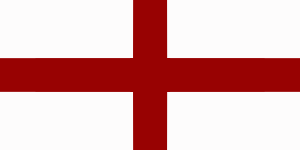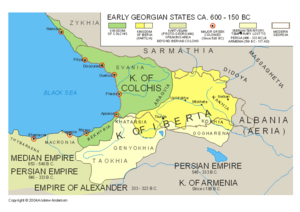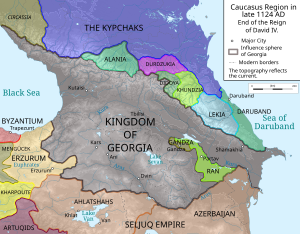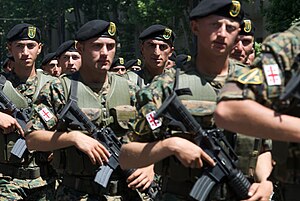
Monument of Battle of Didgori
The country of Georgia has known a rich military history, both as a battlefield of empires and as an independent political and military power. The strategic significance and natural wealth of its territory made it the target of many invasions, and the country's independence was preserved against multiple enemies by a succession of states. Before the unification of the country by the Bagrationi dynasty in the 10th century, several states, such as Iberia and Colchis had managed to subsist between the Roman empire (later Byzantine Empire in the West, and the Sassanid Empire (later replaced by the Umayyad and Abbasid Caliphates. Between the 11th and 15th centuries, the Kingdom of Georgia was a major regional power, which withstood invasions by the Great Seljuk Empire, Mongol Empire, and Timurid Empire, before its fragmentation and submission to the Ottoman and Safavid Empires. Many Georgians fought in the armies of the empires that ruled the country from the 16th century, be it the Safavids, the Russian Empire or the Soviet Union, and the nation kept a reputation for military valour and skill. Since 1991, the newly independent Georgia has taken part in many conflicts: its conflicts with Russia culminated in the 2008 South Ossetia war, while its alliance with the United States led to Georgia's participation in the Afghan and Iraq wars.
Antiquity[]
Kingdom of Iberia[]

Georgian (Iberian) flag in the 4th to 6th centuries
Iberia (Georgian — იბერია, Latin language: Iberia and Greek: Ἰβηρία), also known as Iveria (Georgian language: ივერია ), was a name given by the ancient Greeks and Romans to the ancient Georgian kingdom of Kartli[1] (4th century BC – 5th century AD), corresponding roughly to the eastern and southern parts of the present day Georgia.[2][3] The term Caucasian Iberia (or Eastern Iberia) is used to distinguish it from the Iberian Peninsula, where the present day countries of Spain, Portugal and Andorra are located.
The Caucasian Iberians provided a basis for later Georgian statehood and along with Colchis (early western Georgian state) formed a core of the present day Georgian people (or Kartvelians).[4][5]
Pompey's Georgian campaign[]

Georgian(Colchis) fortress of Surami, built in the 2nd-3rd centuries, heavily fortified in the 12th century
Pompey invaded Georgia in 65 BC after making the Kingdom of Armenia a vassal of Rome. He demanded from the Iberians to become Roman vassals, but the Iberians refused and began partisan wars against Pompey. They were hiding in woods and killing Roman soldiers. Reportedly, a sizable number of women also participated in this irregular warfare. Later in 65 BC the Iberians fought against Pompey over the Aragvi river, Greek historian Plutarch called this battle a great battle and noted that Iberian casualties consisted of approximately 9,000 people, while more than 10,000 were taken captive by Romans. After submitting Iberia, Pompey headed towards the Kingdom of Colchis and subjugated the main fortresses and various local peoples on the way with both cunning diplomacy and the use of force.
Kingdom of Colchis[]

Georgian Colchis and Iberia 600BC-150BC
In ancient Geography, Colchis or Kolkhis (Georgian and Laz: კოლხეთი, ḳolkheti or "ḳolkha"; Ancient Greek: Κολχίς, Kolkhís) was an ancient Georgian[6][7][8][9] state[10][11] kingdom and region[12] in Western Georgia, which played an important role in the ethnic and cultural formation of the Georgian nation.[9][13][14] Its geography is mostly assigned to what is now the western part of Georgia and encompasses the present-day Georgian provinces of Samegrelo, Imereti, Guria, Adjara, Abkhazeti, Svaneti, Racha; the modern Turkey’s Rize, Trabzon and Artvin provinces (Lazistan, Tao-Klarjeti); and the modern Russia’s Sochi and Tuapse districts.[15] The Colchians were probably established on the Black Sea coast by the Middle Bronze Age.[16]
War between Iberia and Armenia[]
The War between Armenia and Iberia (AD 51) is known chiefly through its description in Tacitus' Annals.[17] Fearing usurpation by Rhadamistus, his father convinced him to declare war upon his uncle and claim the Armenian throne for himself. The Iberians invaded with a large army and forced Mithridates to retreat into the fortress of Gorneas (Garni), which was garrisoned by the Romans under the command of Caelius Pollio, a prefect, and Casperius, a centurion. Rhadamistus was unable to take the fortress by assault or by siege. Pollio, swayed by bribery from Rhadamistus, induced the Roman soldiers to threaten the capitulation of the garrison. Under this threat, Mithridates left the fortress in order to make peace with Rhadamistus. Rhadamistus then executed Mithridates and his sons, despite a promise of non-violence, and became King of Armenia. Of this usurpation, Tacitus wrote "Rhadamistus might retain his ill-gotten gains, as long as he was hated and infamous; for this was more to Rome's interest than for him to have succeeded with glory".
Late Antiquty[]
Vakhtang Gorgasal's revolt against Sassanids[]

Georgia in 12th-13th century
In 327 Georgia adopted Christianity and become a Christian state, which caused it to grow more distant from its Zoroastrian neighbor.[18][19][20] From 483 to 522 years Georgian king Vakhtang I "Gorgasali" was fighting against Iran. Persians called him “Gorgasal”, which means wolf, because of his helmet,which was made of a wolf's head, worn by the Georgian king Vakhtang I when he fought against invading Persians. Vakhtang Gorgasali made Georgia a strong regional power. Total number of Georgian Army soldiers under Vakhtang I was under 50,000-60,000 warriors.
Iberian War[]
The Iberian War was a conflict between the Eastern Roman and Sassanid Empires over the the Georgian kingdom of Iberia,which lasted from 526 to 532. It began following a rise of tension between the two empires in the upper Mesopotamian and Transcaucasian regions,and a an anti-Persian revolt in Iberia. The war had ended with the signing of the Treaty of Eternal Peace,in which the Sassanids kept Iberia,and the Byzantines (Eastern Romans) gained the region of Lazica. The treaty had essentially been broken with the start of the Lazic War nine years later.
Lazic War[]
In the Eternal Peace treaty singed between the Sassanid and Byzantine empires,the Sassanids saw Lazica as a region within the sphere of influence of the Byzantines and the Lazic king at the time (Tzath I) was granted baptism from Byzantine Emperor Justinian I in Constantinople. Lazica effectively became a protectorate of the Byzantines,which eventually led to a fullscale revolt in 541,which was supported by the Persian Shah Khosrau I. The revolt essentially overthrew Byzantine control in the region.
However,the tables were turned in 548 when the situation turned against the Persians,and the Lazics began to revolt against the Persians with Byzantine help.
The conflict had ended with a status quo agreement made in 562,in which the Sassanids yet again recognized Lazica as a vassal state of the Byzantine Empire.
Early middle ages[]
War with Umayyad Caliphate[]

Georgian fortress of Tbilisi
War with Umayyad Caliphate took place from 735 to 737. Georgians lost the war and Marwan ibn Muhammad massacred many Georgians.
High Middle Ages[]
Kingdom of Georgia[]

Queen Thamar of the Kingdom of Georgia (reign 12th and 13th centuries)

Georgian medieval flag
Georgia’s power reached its peak in the years from 1180-1236,creating one of the strongest medieval kingdoms with a population of 9-13 million Georgians and with an army of 40,000-90,000 warriors.
Byzantine-Georgian Wars[]
The Byzantine Empire and the Kingdom of Georgia were first began fighting each other in the years 1014-1208 AD. The Byzantines invaded Georgia while Georgia was busy in wars against the Seljuks and Arabs. The Byzantines conquered Georgian territories but as soon as the Kingdom of Georgia found power to fight the third invader, Georgia reconquered Tao-Klarjeti and invaded Byzantium. Soon Georgia conquered Trabzon and finished the war with victory.
Georgian-Seljuk wars[]
Battle of Didgori[]

Caucasus region in late 1124 AD
The Battle of Didgori was fought between the armies of the Kingdom of Georgia(55,000) and Great Seljuq Empire( 300,000)) at Didgori, 40 km west of Tbilisi, (the modern-day capital of Georgia), on August 12, 1121. The battle resulted in King David IV of Georgia’s decisive victory over a Seljuk invasion army under Ilghazi and the subsequent reconquest of a Muslim-held Tbilisi, which became the royal capital. The victory at Didgori inaugurated medieval Georgia’s "Golden Age" and is celebrated in the Georgian chronicles as a "miraculous victory", while modern Georgians continue to remember the event as an annual September festival known as Didgoroba ("[the day] of Didgori").[21]
Battle of Shamkor[]
In June 1, 1195 Georgia crushed a 70,000 manned army of Azerbaijani Atabeg commanded by Abu Bakr with a 35,000 Georgian army commanded by David Soslan,spouse of Tamar. The battle took place at the modern-day Shamkir District in Azerbaijan. Bakr was eventually captured as prisoner after a retreat to Nakhichevan.
Battle of Basian[]
In July 27, 1202 the Georgia crushed a (approx.) 400,000 manned Army of the Seljuqid Sultanate of Rüm in the Basiani Vale,located 60 km northeast from Erzurum with a 65,000 manned army.
Mongol invasions of Georgia and Armenia[]
The first appearance of the Mongols in the Caucasus was in 1220,when the Mongol generals Subutai and Jebe persuaded the Khwarezmian Shah (Muhammad the IInd) to invade Georgia,taking away several regions from the nation. Subutai and Jebe later advanced northwards into the Kievan Rus'. The Mongols had launched a full scale invasion of Georgia in 1236,along with the Empire of Trabizond and the Sultanate of Rum. They took the southernmost regions of the Georgian kingdom in Armenia,effectively annexing the nation,while the Armenian Kingdom of Cilicia and certain Crusader states willingly gave into vassalage. Georgia enjoyed a short period of independence from the Mongols under king George V,though the Timurid invasions eventually lead to its destruction.
Medieval Georgian army[]
From Highest to lowest rank in Medieval Georgian:
- King (Commander of army)
- Amirspasalar (General)
- Tavadi (Prince)
- Aznauri (noble)
- title (Lord)
- Royal Guard (royal cavalry)
- Aznauri cavalry (elite heavy cavalry)
- Mona-Spa (elite cavalry)
- Tadzreuli soldier (heavy infantry, analog of Templars)
- Metsikhovne, khevsur, Mshvildosani, metsikhovne spearman and Kartlian spearman soldiers (Well trained and well armed soldiers, elite)
- Qrma (light infantry, well armed Georgian man, Trained every year by Batons)
Timur's invasions of Georgia[]

Georgian Kingdom in 1460, bordering Kara Koyunlu to the south.
Georgia, a Christian in the Caucasus, was subjected, between 1386 and 1404, to several disastrous invasions by the armies of Turco-Mongol conqueror Timur, whose vast empire stretched, at its greatest extent, from Central Asia into Anatolia.
In the first of at least seven invasions, Timur sacked Georgia's capital, Tbilisi, and captured the king Bagrat V in 1386. Georgian resistance prompted a renewed attack by the Turco-Mongol armies. Bagrat’s son and successor, George VII, put up a stiff resistance and had to spend much of his reign (1395-1405) fighting the Timurid invasions. Timur personally led most of these raids to subdue the recalcitrant Georgian monarch. Although he was not able to establish a firm control over Georgia, the country suffered a blow from which it never recovered. George VII had eventually signed a peace treaty with the Timurids,though his kingdom consisted of little more than gutted towns, ravaged countryside and a shattered monarchy.
Turkoman invasions of Georgia[]
Following the death of Turco-Mongol ruler Timurlane,his empire began fragmenting into smaller states. One of these states was Kara Koyunlu,which took advantage of Georgia's weakness which befell them after several invasions by Timur,and launched an invasion in which they killed the Georgian king George VII. The next king,Constantine I allied himself with Shirvanshah Ibrahim I,however,he was defeated and taken captive in the Battle of Chalagan and was executed along with 300 other Georgians. Alexander I had re-taken Lori from the Turkomans,and encouraged the Armenian king Beskhen II Orbelian to attack the Turkomans in the modern-day Syunik Province in southern Armenia,which he had accomplished and gave Beskhen the Lori province under the terms that he became a vassal. Jahan Shah of Kara Koyunlu had launched two invasion forces into Georgia 1440 and 1444 due to Alexander's unwillingness to pay tribute to the Shah,sacking Tbilisi and other areas.
The Kara Koyunlu were destroyed by the Aq Qoyunlu,whom were tribal kin to Kara Koyunlu and were very similar in many ways. The Aq Qoyunlu took advantage of the fragmentation of Georgia and invaded several times under prince Uzun Hasan. The Georgians had eventually allied themselves with the founder of the Persian Safavid Dynasty Ismail I and defeated the Aq Qoyunlu,putting an end to their invasions.
Georgian Mamluks in Egypt[]
In the thirteenth century, Egyptians began recruiting mainly Christians of Georgia and Circassia as slave soldiers called Mamluks. After 1235, 70 percent of Egyptian Mamluks were Circassians or Georgians in origin and the other 30% were Kipchaks.[citation needed]
Georgian Mamluks in Iraq[]
At the start of the eighteenth century, Georgian Mamluks based in Iraq asserted autonomy from the Ottoman Empire and founded a dynasty which ruled an autonomous Iraq until 1831, when the Ottomans reimposed direct rule.
- Hasan Pasha (1704–1723)
- Ahmad Pasha (1723–1747) son of Hasan
- Sulayman Abu Layla Pasha (1749–1762) son of Ahmad
- Omar Pasha (1762–1776) son of Ahmad
- Sulayman Pasha the Great (1780–1802) son of Omar
- Ali Pasha (1802–1807) son of Omar
- Sulayman Pasha the Little (1807–1813) son of Sulayman Great
- Said Pasha (1813–1816) son of Sulayman Great
- Dawud Pasha (1816–1831)
Georgian weapons[]
King David "the Builder" made his own sword,naming it "Khmali" (literally meaning "Sword" in Georgian) and supplied his army with it. The Georgians called it "Davitiuri" which means "sword of David" in English. David personally called it "Sword of Messiah".
The Georgian "Davitiuri" sword was a mixed type of theEuropean Knightly sword and the Persian bow sword. Later this type of sword led Georgians into the Golden age of Georgia in 11-12th centuries. The Georgian "Davitiuri" sword was adopted by all Caucasian nations and became a Caucasian sword.
Early modern period[]
Georgian-Safavid wars[]
Georgian-Ottoman wars[]

Georgian cavalry in 1918.
After Mongol invasions and collapse of Kingdom of Georgia, From 16th century to 19th Georgia was Fighting against Persian, Ottoman, and Russian Rule in the battles of
- Battle of Kiziki (1520)
- Battle of Teleti (1522)
- Battle of Garisi (1556)
- Battle of Digomi (1567)
- Battle of Partzkhisi (1569)
- Battle of Nakhiduri (1600)
- Battle of Tashiskari (1609)
- Battle of Martqopi (1625)
- Battle of Marabda (1625)
- Battle of Bazaleti (1626)
- Battle of Khresili (1757)
- Battle of Aspindza (1770)
- Battle of Krtsanisi (1795)
- Georgian–Armenian War (1918)
- Turkish Georgian war (1918)
- Sochi conflict (1918-1919)
- Soviet invasion of Georgia (1921)
In 19th century Russia annexed Georgia and Georgians began partisan wars against the Russians. In the early 20th century Georgia declared independence from Russia. In 1921,the newly established Bolshevik faction invaded and annexed Georgia.
Modern period[]
World War I[]
Georgia fought in the first world war within Russia and some at side of Germany. 200,000 soldiers were sent to the war out of a population of 1.5 million. 15,000 Soldiers fought at side of Germany in the Georgian Legion.
World War II[]

Joseph Stalin, born Joseph Jughashvili in Georgian
Georgia sent up to 700,000 soldiers at side of Soviet Union out of a 3 million total population to the war, 300,000 soldiers died and around 400,000 soldiers returned. 30,000 Fought at side of the Axis within the Georgian Legion, some fought out of Georgian Legion in SS and Luftwaffe. The 882nd Infantry Battalion of the Georgian Legion under the command of Shalva Loladze had revolted against the Germans on the 5th of April 1945 in Dutch region of Texel. (See Georgian uprising on Texel)
Notable Georgian commanders of World War II:
Joseph Stalin, Konstantine Leselidze, Vladimir Janjgava.
Wars against Russia[]
- In 1801 Russia betrayed the Treaty of Georgievsk and occupied the Georgian kingdom of Kartl-Kakheti.
- in 1810 Russia occupied Kingdom of Imereti
- in 1828 Russia occupied principality of Guria
- in 1856 Russia occupied principality of Samegrelo-Zemo Svaneti
- in 1865 Russia occupied Abkhazia
- in 1921 Russia occupied Democratic Republic of Georgia (3,000 soldiers and 6,000 civilians were killed; Russia lost 5,500 soldiers and 2,500 were captured by Georgia) (See Soviet invasion of Georgia)
- in 1924 thousands of Georgian freedom fighters (including People from Abkhazian Region) were killed during the August Uprising.
- in 1989, 9 April, 21 students were killed during a meeting in Tbilisi
- in 1992 Russia occupied Samachablo(So called South Ossetia)
- in 1993 Russia occupied autonomy of Abkhazia
- in 2008 Russia invaded in Georgia killing 160 soldiers and 534 civilians(including Ossetian civilians killed in Tskhivali massive air strikes)
In the last 200 years, there were 8 wars against Russia, but Russia still occupies 20% of Georgian territory. Russian-Georgian wars still active.
Georgia[]
Georgia declared independence from the Soviet Union on the 9th April 1991. After gaining independence, Abkhazia and South Ossetia declared independence from Georgia,which lead to a civil war in which Russia directly supported the Abkhazians. The conflict between Georgia and its separatist territories still have not yet been resolved today.
Georgian army in 2012[]

Georgian Armed forces.

Georgian Armed forces in Iraq.

Georgian Armed Forces.
After the Rose Revolution, Georgia began reforms of its armed forces, the number of soldiers increased from 15,00 to 37,000 and theGeorgian soldiers began training together with US Marine Corps. Georgia bought armament from the USA, Israel, Ukraine, Czech, Poland etc. Georgia's land forces are equipped with M4 carbine (main), Negev Img, M134, M40 rifle, M24 Sniper Weapon System, Sako TRG and other weapons. Georgia began full rearming to remove Soviet armament. The structure of the Georgian Land Forces is based on brigade and battalion-sized military units. The main force consists of five infantry and two artillery brigades with additional brigades or battalions attached. Georgian brigades have a total manpower of up to 5,500+. The overall strength of the land forces is 37,553 (excluding active reserve), from which 21 are high-ranking officers, 6,166 officers and sergeants, 28,477 corporals, 125 cadets and 388 civilians. The ground forces are equipped with a great variety of weapons and vehicles. The light infantry presents the backbone of the Georgian army and is being trained on the model of US Marines as a quickly deployable direct action vanguard, while the actual infantry acts as supportive arm. Special forces operate independently under MOD directivity. In 1999 Georgia created a Georgian special operations battalion with help from Turkey, after 2004 this secret battalion began Training together with Special Forces of the U.S Army. Now, the Georgian special operations battalion is one of the best MOD special forces in Eastern Europe. In 2011 Georgia made reserve forces who will be trained and equipped until 2013. 140,000 reserve forces will be ready to 2013, with 70,000 in 2012. 40,000 reservists will become territorial reserve forces under command of Police 100,000 reservists will become army reserve to support Regular army during war. Georgian reserve forces are equipped with AK-47, AK-74M, RPG-7, SVD and other former equipment of Georgian regular army. Total number of reservists suitable for military service (27–40 years old males) is 900,000. Georgia created its own Military industry and has already produced:
- Lazika (Infantry fighting vehicle)
- Didgori Armoured Personnel Carrier
- Didgori-2
- Didgori-3
- TAAV (Georgian made ”MRAP”, Three-Axle Armored Vehicle, holds 8 kg mine blast, and 7x62x51mm bullets)
- ZCRS-122 (multiple rocket launcher, and its 122mm missiles.)
- Georgian unmanned aerial vehicle
- G5 rifle (G5 rifle with its 5.56mm bullets)
- RPG-7 (Heavily modified Georgian version of Soviet RPG-7)
- RPG-22 (Heavily modified Georgian version of Soviet RPG-22)
- RPG-18 (Heavily modified Georgian version of Soviet RPG-18)
- PDM-1 (Georgian Grenade launcher, based on RPG-26)
- 2B14 Podnos (Heavily modified Georgian version of 82mm Mortar)
- M-43 (Heavily modified Georgian version of 120mm Mortar)
- Mkudro (silent attack hand mortar 40mm-82mm)
- AG-40 (Georgian copy of Romanian AG-40)
- DELGA-1 (Georgian made fast attack vehicle)
- P-9 pistol (Georgian made 9mm pistol)
- Ballistic vests (Georgian made Ballistic vest)
- Helmet
- Uniforms (Georgian-made uniforms are very durable; it is hard to see these uniforms under night vision optics)
Upgrades
- Su-25KM "Scorpion" (Tbilisi Aircraft Manufacturing produced more than 800 SU-25, today the production of Su-25 is stopped, but “Delta’s” Tbilisi Aircraft Manufacturing modernizes SU-25 to Su-25KM "Scorpion". “Scorpion” is fare better plane than old SU-25, it has improved avionics and electronics. Unlike SU-25, “scorpion” is suitable for night strike.)
- T-72 SIM-1 (T-72 SIM-1 - Increased implementation of K-1 reactive and K-5 passive armor. New FALCON command and control system, GPS navigation system and Polish SKO-1T DRAWA-T fire control system with thermal imager and laser rangefinder (from PT-91 Twardy).[22] It has also a friend-or-foe recognition system.)
- P-109 patrol boat (70,000 kg) deep modernized Coast guard boat. In 2012 the USA built a Boat modernization factory in Batumi.
Future production In 2012, Georgia’s president Mikheil Saakashvili said that Georgia will produce it's own made surface to air missile system. From 1946 to 1989 Georgia was producing air to air missiles, for example air-to-air R-60 and R-73 IR guided missiles. Total number of produced missiles was 6,000.
Georgian MOD said that Georgia is working on a few new products and improvement of already produced vehicles. Also,the Georgian president said that Georgia will present the first Georgian Armed unmanned aerial vehicle in 2013.
References[]
- ↑ Course of Ancient Geography, Henry Immanuel Smith, p. 279.
- ↑ The Roman Eastern Frontier and the Persian Wars, Geoffrey Greatrex, Samuel N. C. Lieu, p. 82
- ↑ The Emperor Domitian, Brian W. Jones, p. 156.
- ↑ Ronald Grigor Suny. The Making of the Georgian Nation. Indiana University Press, p. 13 ISBN 0-253-20915-3.
- ↑ William Coffman McDermott, Wallace Everett Caldwell. Readings in the History of the Ancient World. p. 404.
- ↑ Ronald Grigol Suny, The Making of the Georgian Nation, p 9
- ↑ Georgia in Antiquity: A History of Colchis and Transcaucasian Iberia, 550 BC-AD 562, David Braund Oxford: Clarendon Press, 1994. Pp. 359
- ↑ The Making of the Georgian Nation, Ronald Grigor Suny, p. 13
- ↑ 9.0 9.1 Modern Hatreds: The Symbolic Politics of Ethnic War, Stuart J. Kaufman, p. 91
- ↑ Cyril Toumanoff, Studies in Christian Caucasian History, p 69
- ↑ One Europe, Many Nations: A Historical Dictionary of European National Groups, James Minahan, p. 282
- ↑ Marc Van de Mieroop, A History of the Ancient Near East, ca. 3000–323 BC, p 265 ISBN 978-1405149112
- ↑ Charles Burney and David Marshal Lang, The Peoples of the Hills: Ancient Ararat and Caucasus, p. 38
- ↑ Oliver Wardrop, The Kingdom Of Georgia: Travel In A Land Of Women, Wine And Song (Kegan Paul Library of History and Archaeology)
- ↑ Andrew Andersen, History of Ancient Caucasus, p. 91
- ↑ David Marshal Lang, the Georgians, Frederich A. Praeger Publishers, New York, p 59
- ↑ Tacitus. Annals. Book XII, Chapters 44-51. http://en.wikisource.org/wiki/The_Annals_%28Tacitus%29/Book_12#44. Retrieved May 10, 2012.
- ↑ Theodor Dowling, Sketches of Georgian Church History, New York, 1912, p 37
- ↑ Charles Burney and David Marshal Lang, The Peoples of the Hills: Ancient Ararat and Caucasus, p. 22
- ↑ Allen, W.E.D.: A History of the Georgian People, 1932, p. 64
- ↑ Suny, Ronald Grigor (1994), The Making of the Georgian Nation, p. 36. Indiana University Press, ISBN 0-253-20915-3
- ↑ "Бронетехника в грузино-осетинском конфликте август 2008 - 0001.htm". Vadimvswar.narod.ru. http://vadimvswar.narod.ru/ALL_OUT/TiVOut0809/GruzPz08/GruzPz08001.htm. Retrieved 2012-08-26.
| ||||||||
The original article can be found at Military history of Georgia and the edit history here.